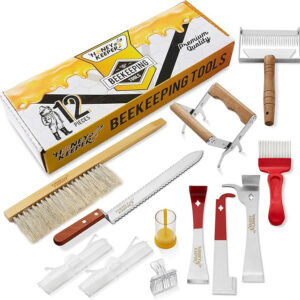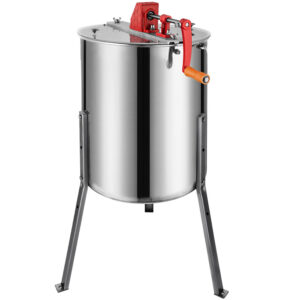Backyard beekeeping is an increasingly popular pursuit among farming enthusiasts and nature lovers. It offers a unique opportunity to engage with the environment, support local ecosystems, and enjoy the sweet rewards of home-harvested honey. If you’ve ever found yourself captivated by the fascinating world of bees, you’re not alone. As someone who has delved into this rewarding hobby, I’d like to share insights drawn from personal experience and expert knowledge to help you embark on your beekeeping journey.
Understanding Bee Biology
Before you even think about setting up your hive, it’s crucial to understand the biology and social structure of honeybees. Honeybees, particularly the species Apis mellifera, live in complex societies consisting of three main types: the queen, workers, and drones. The queen’s primary role is reproduction; she can lay thousands of eggs daily during peak seasons. Worker bees take on many responsibilities, including foraging for nectar and pollen, maintaining the hive, and caring for the brood. Drones, the male bees, exist solely to mate with a queen.
Understanding this social structure is vital for effective hive management. For instance, if your hive becomes too crowded, the queen may decide to swarm, leading to a portion of the colony leaving to establish a new hive. This natural behavior can be managed by recognizing the signs of a crowded hive and taking preventive measures, such as splitting the colony.
Having a strong grasp of bee biology not only enhances your ability to manage a hive but also deepens your appreciation for these remarkable insects. As I learned through my own experiences, observing the interactions within the colony can be mesmerizing and provides valuable insights into their needs and behaviors.
Choosing Your Hive Type

Once you’ve familiarized yourself with bee biology, the next step is selecting the right hive. For beginners, the Langstroth hive is often recommended due to its user-friendly design. It features removable frames, allowing for easy inspections and honey harvesting. When I first set up my Langstroth hive, I felt a mix of excitement and apprehension. I vividly remember the day I placed it in a sunny corner of my yard, only to later learn that bees are often attracted to dark, earthy colors rather than the bright hues I chose.
It’s important to consider the size of your space and local climate when selecting a hive type. Other popular options include Top-Bar hives, which are more natural and easier to manage, and Warre hives, which are designed for minimal intervention. Each type has its pros and cons, so researching and potentially visiting local beekeepers for hands-on experience can greatly inform your decision.
Preparing Your Location
The placement of your hive is just as critical as choosing the right type. Ideally, your hive should be in a sunny spot, sheltered from strong winds, and close to a water source. A south-facing orientation helps the hive warm up quickly in the morning, encouraging foraging activity throughout the day.
Additionally, consider the flight path of your bees. Placing the entrance away from high-traffic areas reduces the likelihood of bee-human conflicts, which can be a concern in urban settings. I found that placing my hive near a flowering garden not only provided ample food sources for my bees but also attracted them to the area, enhancing their productivity.
By incorporating native plants that bloom at different times throughout the growing season, you can ensure a steady food supply for your bees. This approach not only supports your hive but also contributes positively to local biodiversity.
Acquiring Your Bees
Once your hive is prepared and in the right location, it’s time to acquire your bees. There are several methods to obtain bees, including purchasing a package, acquiring a nucleus colony (nuc), or capturing a swarm. Each method has its challenges and benefits.
When I started beekeeping, I opted for a package of bees, which included a queen and several thousand workers. I remember the mix of excitement and nervousness as I opened the package to introduce them to their new home. Following the instructions carefully, I successfully released the queen, and to my surprise, the bees created a swirling cloud around me, as if welcoming me into their world.
Local beekeeping clubs and associations can provide valuable resources for acquiring bees and offer workshops that allow you to learn from experienced beekeepers. This community support can be invaluable as you navigate the early stages of beekeeping.
Regular Hive Maintenance
Regular inspections are vital for maintaining a healthy hive. As a beginner, I remember my first inspection vividly; my hands were shaking as I lifted the hive’s top. The thrill of discovering the queen actively laying eggs and the workers diligently collecting nectar was unforgettable. However, I also encountered my first challenge: a small amount of wax moth larvae. Initially, panic set in, but I quickly learned that this was a common issue in beekeeping.
Establishing a consistent inspection schedule not only helps in managing your hive but also strengthens your connection with the bees. During inspections, look for signs of disease, adequate food storage, and the queen’s presence. Additionally, familiarize yourself with Integrated Pest Management (IPM) strategies to keep pests like Varroa mites at bay without relying solely on pesticides.
Embracing Challenges and Learning Through Experience
Backyard beekeeping is undeniably a learning journey filled with both rewards and challenges. Mistakes are bound to happen, and it’s essential to embrace them as part of the process. I vividly remember one summer when my hive swarmed, and I felt a wave of panic wash over me. However, after consulting with local beekeepers and adjusting my management practices, I learned how to prevent future swarming and successfully expanded my beekeeping operation.
Participating in beekeeping workshops and local associations has also enriched my knowledge and provided a support network of fellow enthusiasts. Sharing experiences and learning from others is invaluable, especially when faced with common challenges like disease management or honey extraction. I found that mentoring new beekeepers has not only solidified my understanding but also fostered a sense of community around this rewarding hobby.
Enjoying the Sweet Rewards
One of the most gratifying aspects of backyard beekeeping is the ability to harvest your own honey. After a season of diligent care, I was thrilled to collect my first batch of honey. The experience of extracting honey, bottling it, and sharing it with friends and family brought immense joy.
Beyond honey, bees also produce beeswax, propolis, and royal jelly, each with its own uses and benefits. Learning how to utilize these products can further enhance your beekeeping experience and provide additional revenue streams if you choose to sell them.
As you embark on your journey, remember that patience is key. Each season brings new lessons and experiences that will enrich your knowledge and deepen your appreciation for these remarkable insects.
Final Thoughts
Backyard beekeeping is a fulfilling endeavor that allows you to connect with nature while contributing positively to the environment. By understanding bee biology, choosing the right equipment, preparing your hive location, acquiring bees, and embracing the learning process, you can cultivate a thriving bee colony.
If you’re ready to take the plunge, I encourage you to seek out local resources, connect with fellow beekeepers, and enjoy the sweet rewards that come with this incredible journey. Happy beekeeping!
Resources:
Cornell Pollinator Network Resources
Beekeeping Basics | Pollinator Network – Cornell CALS


